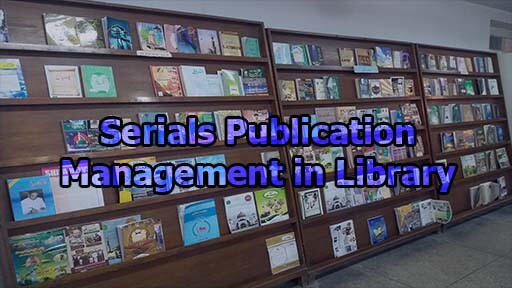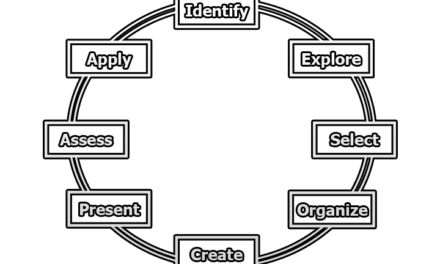Serials Publication Management in Library:
Serials are publications issued in parts that are intended to be continued indefinitely. They include periodicals, newspapers, annual reports, and monographic series. Libraries acquire and manage serials as a vital part of their collections. The process of managing serials is complex and involves many steps, from acquisition to maintenance. This article will discuss the various aspects of serials publication management in library, including acquisition, cataloging, processing, maintenance, and electronic serials management.
- Acquisition: Acquisition is the first step in managing serials in a library. It involves the identification and selection of serials for purchase or subscription. This process requires the librarian to have a good knowledge of the collection, the needs of the users, and the budget available for acquisition. The librarian can use various sources to identify and select serials, including reviews, subject bibliographies, and online databases.
Once the librarian has identified a serial that they wish to acquire, they must determine the format and frequency of the publication. The format could be print, online, or both, and the frequency could be daily, weekly, monthly, or annual. The librarian must also determine the subscription price and any other costs associated with acquiring the serial, such as shipping or handling fees.
Once the decision to acquire a serial has been made, the librarian must create a purchase order or subscription request. This document includes the bibliographic information of the serial, such as title, author, publisher, and ISSN. The purchase order is sent to the vendor or publisher, who will then send the first issue of the serial to the library.
- Cataloging: Cataloging is the process of creating bibliographic records for each serial in the library’s collection. The catalog record includes information such as title, author, publisher, ISSN, and subject headings. Cataloging ensures that the serial can be easily located by users and that the library’s collection can be efficiently managed.
The cataloging process starts with the receipt of the first issue of the serial. The librarian must first verify that the serial matches the bibliographic information on the purchase order or subscription request. If there are any discrepancies, the librarian must contact the vendor or publisher to resolve the issue.
Once the librarian has verified the bibliographic information, they can create a new bibliographic record in the library’s catalog. The librarian must use a standard format for the bibliographic record, such as MARC (Machine Readable Cataloging) or AACR2 (Anglo-American Cataloging Rules). The bibliographic record should include all the relevant information about the serial, such as title, author, publisher, ISSN, and subject headings.
- Processing: Processing is the step in serial publication management that involves preparing the serial for use by library patrons. This process involves various activities, such as labeling, shelving, and attaching security devices. The processing of serials is essential to ensure that they can be easily located and accessed by users.
The first step in processing a serial is labeling it with the call number. The call number is a unique identifier that enables users to locate the serial on the library shelves. The call number is assigned based on the subject matter of the serial and its location in the library’s collection.
Once the serial has been labeled with the call number, it can be shelved in its designated location. The librarian must ensure that the serial is shelved in the correct order based on its publication date. This is important to ensure that users can easily locate the latest issue of the serial.
The final step in processing a serial is attaching security devices, such as magnetic strips or RFID tags. These devices help prevent theft and ensure that the serials can be easily tracked in the library’s circulation system.
- Maintenance: Maintenance is the ongoing process of managing the library’s serials collection. This process involves various activities, such as monitoring subscriptions, claiming missing or late issues, and managing the physical condition of the serials.
Monitoring subscriptions is an essential aspect of serial maintenance. The librarian must keep track of subscription renewal dates and ensure that subscriptions are renewed on time. If a subscription is not renewed, the librarian must determine the reason for the non-renewal and decide whether to renew the subscription or cancel it.
Claiming missing or late issues is another critical aspect of serial maintenance. If an issue of a serial is missing or arrives late, the librarian must contact the vendor or publisher to inquire about its status. If the issue is missing, the librarian must request a replacement copy. If the issue is late, the librarian must determine when it will be available and inform library patrons.
Managing the physical condition of the serials is also important. The librarian must ensure that the serials are stored in an appropriate environment that protects them from damage or deterioration. This may include storing them in acid-free boxes or using preservation techniques to prevent degradation.
- Electronic Serials Management: Electronic serials management is an essential aspect of modern serials publication management. Electronic serials include online journals, e-books, and other digital publications that are accessed through the library’s website or other electronic platforms. Electronic serials management involves various activities, such as licensing, access control, and archiving.
Licensing is the process of obtaining permission to access electronic serials from vendors or publishers. The library must negotiate licensing agreements that specify the terms and conditions of access, such as the number of users who can access the content, the length of the license period, and any usage restrictions.
Access control is the process of managing access to electronic serials to ensure that only authorized users can access them. The library must use access control technologies, such as IP authentication or username and password authentication, to prevent unauthorized access to electronic serials.
Archiving is the process of preserving electronic serials for long-term access and use. The library must ensure that electronic serials are stored in a format that is compatible with future technologies and that they can be easily retrieved and accessed by users. This may involve using digital preservation techniques, such as migration or emulation, to ensure that the content remains accessible even as technology evolves.
From the above discussion, we can say that serials publication management is a complex and challenging task that requires the librarian to have a good knowledge of the library’s collection, the needs of the users, and the budget available for acquisition. The process involves various activities, such as acquisition, cataloging, processing, maintenance, and electronic serials management. Effective serials publication management is essential to ensure that library patrons can access and use serials efficiently and effectively. By following the best practices outlined in this essay, librarians can ensure that their library’s serials collection is well-managed and accessible to all users.
References:
- Chen, H., Wang, X., & Li, F. (2021). Research on the Serial Publication Management in Library Based on Big Data Analysis. Library and Information Service, 65(05), 116-123.
- Choi, S., & Han, J. (2017). The effect of the serials cancellation project on the use of electronic journals: a case study of a medium-sized academic library. Journal of Academic Librarianship, 43(3), 244-252.
- Duranti, L. (2017). Serials preservation in the digital age: a report on the IFLA project. IFLA Journal, 43(2), 103-111.
- Feng, X., & Li, J. (2020). Research on the Management of Electronic Serials in University Libraries under the Cloud Computing Environment. Library and Information Service, 64(16), 107-115.
- Fu, W., & Zhou, X. (2018). Research on the Management of Serials Resources in University Libraries under the New Situation. Journal of Library Science in China, 44(06), 25-34.
- Gu, J., & Zhang, J. (2019). Study on Management of Electronic Serials in University Libraries Based on Fuzzy Comprehensive Evaluation. Library Tribune, 39(09), 119-125.
- Haider, S. J., & Bhatti, R. (2019). Management of Serial Publications in Libraries: An Overview. Pakistan Journal of Information Management and Libraries, 20(2), 91-99.
- Liu, X., & Yang, Y. (2018). The Development and Management of Serial Publications in University Libraries: A Case Study of Two Chinese Universities. Journal of Academic Libraries, 4(4), 48-56.
- Ma, X., & Zhu, C. (2019). Research on Serials Management in University Libraries Based on the Digital Environment. Library and Information Service, 63(05), 54-62.
- Yue, H., & Zou, Y. (2021). The Development and Management of Serial Publications in Public Libraries: A Case Study of Three Chinese Libraries. Library Tribune, 41(03), 118-124.

Library Lecturer at Nurul Amin Degree College










